Transformer Efficiency Formulas and Example Problems
Loading...
Ever heard of the word transformer? In contrast to transformers that can change from vehicles to robots, transformers or transformers can control electric current in a machine. The transformer also uses the efficiency formula.
This formula finally works to optimize the flow of electricity to an object so that the flow is efficient without wasting anything. You can also, you know, find various types of objects around that use a transformer.
List of contents
What is a Transformer?
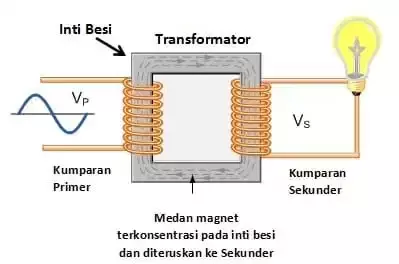
Transformer is a device that converts AC voltage. Both high and low currents can be transformed back and forth using this one tool. Transformers are also known as transformers. There are at least two types of transformers that can be used according to the dimensions of the machine.
1. Step Up Transformer
The first type of transformer commonly used in large machines is the step up transformer. Where the transformation tool works to increase the current voltage received so that the results of the electric current are maximized. Of course, you need careful calculations using the transformer efficiency formula when you want to build this machine.
One of the step up transformers is used in electric generators. You can imagine how much electrical power must be used for the machine to work optimally.
2. Step Down Transformer
The second type is the down transformer. This type of transformer is more widely used because it can reduce the electric current is too large. Even this transformer is used so that the tool does not overheating or at worst explode.
The down transformer works to reduce the electric current in the types of tools that are often used daily. Some examples are different types of chargers, power supplies, and adapters.
Read: Power Formula
Transformer/Transformer Parts
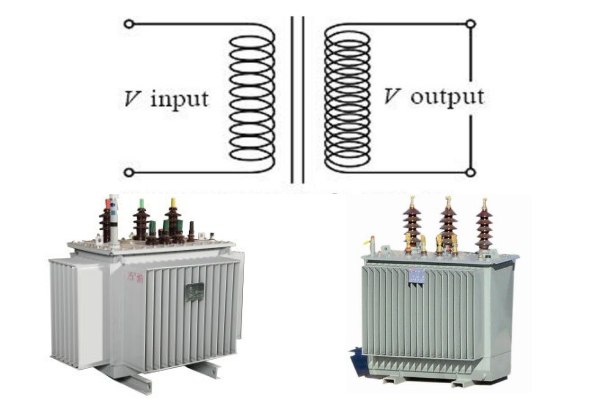
There are at least 8 common parts contained in every transformer tool. But not everyone can recognize every part of this tool. Let's get acquainted, let's, with the common parts in this converter of current values.
1. Machine Core
As the name suggests, this section is arguably the center that regulates all machine procedures. The core of the machine or the core of this transformer is wrapped around with quite a lot of coil wire. When electricity comes, a flux current will induce a coil of wire and eventually complete electricity is created.
2. coil
The coil is a machine part in the form of a wire. Not just any wire, the machine uses the best type of wire that can conduct electric current quickly. There are two types of coils namely primary coil and secondary coil.
3. Insulator Coating
This layer is the part that functions as a barrier to electric current. However, there are some parts where the currents are prohibited from meeting or colliding with each other. So this part serves as a preventer current connection.
4. Transformer Case
As an outer frame, the transformer case serves to keep the engine core inside. In fact this part works as a protector as a whole. The main material of the maker is metal that is heat, water and anti-rust as much as possible.
5. Bushing or Terminal
This section serves as a liaison transformer to the circuit section. Brushing is installed at each end of the coil. This section usually has a section sticking up which is connected by an electrical cable on the outside.
6. Conservatory Tank
However, the transformation tool requires cooling oil to reduce the heat generated by the engine. However, cooling oil (oil) cannot be placed carelessly. The conservator section also functions to control the amount of oil to be used.
7. Breather
Also one of them functions as a cooling option for the transformer as a whole, the Breather can regulate the flow of air that goes directly into the engine cavity. This part is installed at the end of the air pipe with silica gel as a moisture absorber.
8. Radiator
Finally, the radiator serves as the engine's main coolant. Unlike laptop radiators, transformer radiators are striped which can work optimally to provide direct cooling to all parts of the engine.
Transformer Loss Factor

The loss factor is one of the factors why the transformer machine cannot work ideally. Not only failed in calculating the efficiency formula, but there were other factors as well. Some other factors include:
- The eddy current in the magnetic core opposes the flux current
- Alternating current that only flows on the cross-sectional surface of the conductor which will have an impact on the amount of capacity loss and increase in relative resistance.
- The AC primary current reverses again because the transformer cannot change the direction of the flux.
- Stray current capacity in the transformer coil winding which usually occurs in large machines.
- The secondary and primary couplings do not work properly and cause all the flux current induced in the primary winding to cut the secondary winding.
- Poor resistance of copper wire causes dissipation of power current when electricity is passed.
Each loss factor can be initiated by replacing the material with a higher quality material. You can also pay attention to the machine's performance every day and immediately repair the damaged parts so they don't spread.
Read: Law of Immunity of Energy
What is Transformer Efficiency?
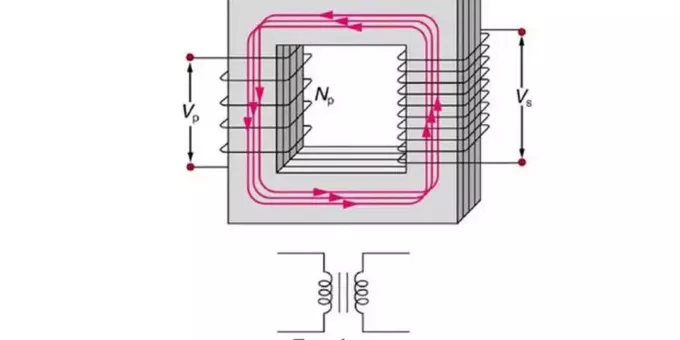
Have you heard of transformer efficiency before? If not, this term is closely related to the electrical power that enters and leaves the machine. Based on this concept, efficiency is divided into two, namely ideal transformers and non-ideal transformers.
The ideal transformer has an efficiency of up to 100% with rated power out = power in. While the transformer is not ideal, which occurs when the energy out is less than the energy in. In the case of a transformer that is not ideal, energy could be lost due to heat or other things.
Transformer Efficiency Formula
This formula is used to find the efficiency value of the performance of a transformer, either a step down or step up transformer. The formula is simply a comparison between the output power (power released) with the input power (power that enters the engine). The formula is:

Information:
Advertisement
: Transformer efficiency
Po: Output power (Watts)
Pi: Input power (Watts)
Another formula that can be used is to use the formula for input voltage and output voltage. You can use this formula if the data presented in the problem mentions the value of the input and output voltages. The formula you can use is:
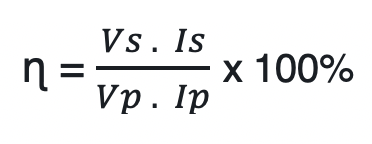
: Transformer efficiency
Vs (Vs): Output voltage / secondary voltage (Volts)
Vp(Vp): Input voltage/primary voltage(Volt)
Is (Is): Output current (Amperes)
Ip (Ip): Input current (Amperes)
Read: Conductor
Sample Questions and Discussion

It is not complete if you already know the efficiency formula without seeing an example of the problem. We have two sample questions that you can use as an overview. Here's an example of a question that you can operate on your own.
Example question 1
A transformer with a primary (input) voltage of 50 W and a secondary (output) power of 40 W. what is the value of the transformer efficiency?
Bro:
Po: 40
Pi: 50
Dit:
Answer:
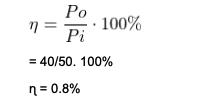
So, the transformer efficiency value above is 0.8%.
Example question 2
What is the value of the secondary current in a transformer with 75% efficiency, the primary voltage is 220 V, the secondary voltage is 100 V, and the primary current is 1 A.
Bro:
ɳ: 75%
Vo: 100 V
Vi: 220V
Ii: 1 A
Dit: Io
Answer:

75% = 100. X/220. 1. 100%
75%/100% = 100. X/220. 1
- 75 = 100. X/220
Io = 1.65 A
So, the value of the secondary current = 1.65 Amperes.
The two questions above are purely using the efficiency formula. You can dissect the use of formulas yourself in other example questions. Don't forget to make adjustments first between the questions and the type of data available in the questions.
X CLOSE
Advertisements
ADVERTISEMENT
X CLOSE
